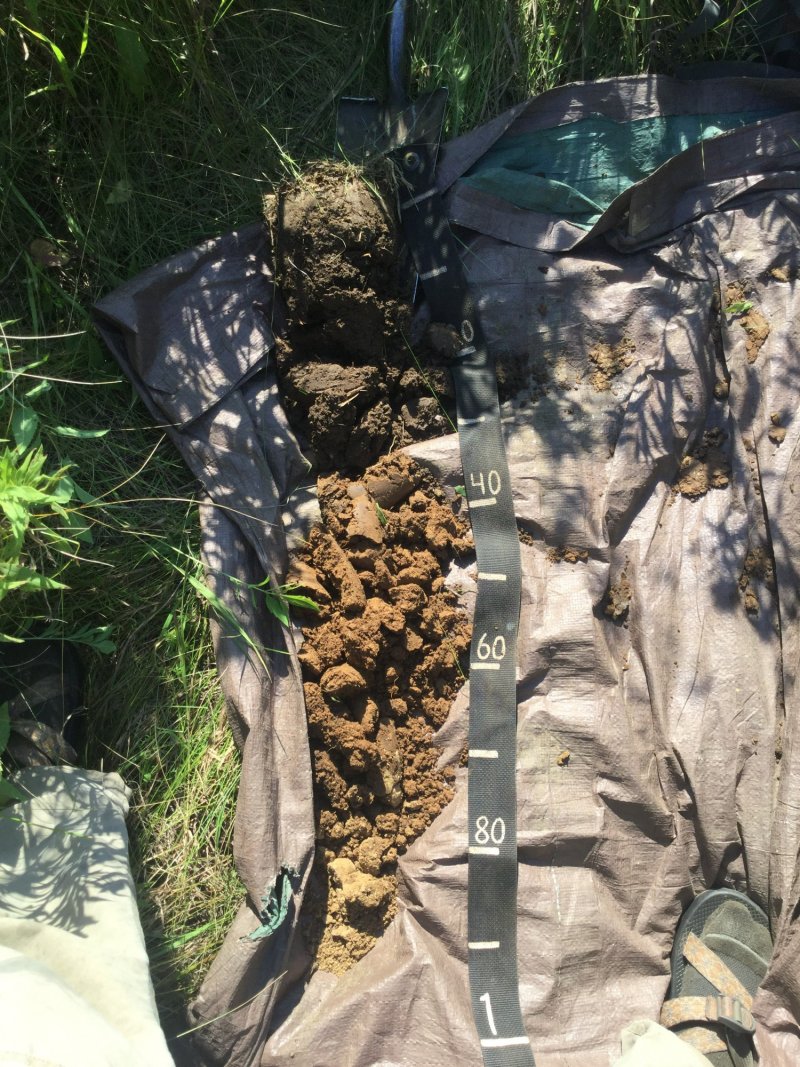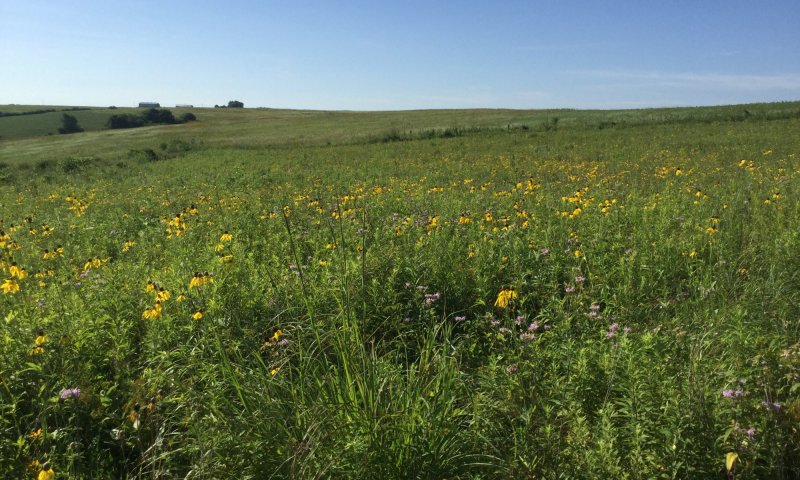

Natural Resources
Conservation Service
Ecological site R105XY014WI
Mollic Clayey Upland
Last updated: 2/23/2024
Accessed: 11/21/2024
General information
Provisional. A provisional ecological site description has undergone quality control and quality assurance review. It contains a working state and transition model and enough information to identify the ecological site.
MLRA notes
Major Land Resource Area (MLRA): 105X–Upper Mississippi River Bedrock Controlled Uplands and Valleys
The Northern Mississippi Valley Loess Hills area corresponds closely to the Western Coulees and Ridges and Southwest Savanna Ecological Landscapes. Some of the following brief overview is borrowed from the Wisconsin Department of Natural Resources Ecological Landscape publication (2015).
Fifty-two percent of the Upper Mississippi River Bedrock Controlled Uplands and Valleys MLRA is in Wisconsin; Iowa, Minnesota, and Illinois contain the rest. This region is the only area in Wisconsin that has not been covered by glaciers within the past 2.4 million years. The Wisconsin portion of this MLRA is approximately 7.4 million acres (11,600 square miles). The landscape is characterized by dissected topography with deeply-incised, steep-walled valleys between bedrock controlled ridges.
Though it’s called the “Driftless Region”, some glacial drift is found in the major river valleys of this region in the form of outwash, deposited by proglacial streams of glacial meltwater. Wisconsin’s most recent glaciations also impacted the sediment of the area through the deposition of loess. After the glacier receded and before vegetation established, the bare surfaces of the glaciated areas were highly susceptible to wind erosion. As a result, a veneer of loess (wind-blown silt) was deposited over the entire region. The thickest deposits—nearly five meters—are on ridges near the Mississippi River and gradually thin moving eastward. The loess caps in Dane and Green counties are generally 0.5-1.5 meters deep. Much of the loess has eroded downslope and collected in floodplains.
Bedrock is shallow throughout this MLRA and is a major influence on topography and hydrology. Most of the MLRA has bedrock within two meters, except in the deep river valleys that are filled with outwash and alluvium materials. Sandstone is the dominant bedrock type in MLRA 105, but the southernmost portion is dominated by dolomite. Military Ridge is an escarpment that straddles the boundary between sandstone and dolomite bedrock. The sandstone north of the ridge is weaker than the erosion-resistant dolomite south of the ridge. The sandstone is deeply cut and dissected into steep slopes and valleys. The dolomite-controlled ridges tend to be less dissected and broader with more gentle, south sloping topography. Geomorphic and fluvial processes formed these landscapes by way of sheet wash, soil creep, and flowage. These processes eroded the hillslopes, cut into bedrock, and transported the debris to streams, forming floodplains and terraces.
Underfit streams are common in MLRA 105, especially in the southern portion. These streams currently occupy large river valleys—especially those of the Black, Chippewa, Mississippi, and Wisconsin Rivers—that were carved by proglacial meltwater streams carrying much larger quantities of water than what’s present today. As the climate dried, waterflow decreased and the valleys filled with alluvial sediment. Narrow meanders were formed by the shrinking streams and are often dissimilar to the meanders of the larger valleys they occupy. Fluvial landforms – including terraces, oxbow lakes, sandbars, eroding bluffs, and large floodplain complexes – are found within these large valleys and are subject to varying flooding frequencies, intensities, and durations.
Karst topography formed in this region from dissolution of carbonate bedrock by surface and groundwater. Dolomite and limestone are more easily affected by dissolution, but karst topography also formed in sandstone. Erosion by water (stream meanders, rain/runoff, and groundwater), wind, and frost weaken joints and bedding planes that can cause collapse. In addition, sandstone materials collapse into cavities in underlying dolomite or limestone.
Historically, MLRA 105 was dominated by oak forests and oak openings making up more than 50% of the area. Prairies were significant and covered 32% of the area south of Military Ridge. Maple-basswood forests covered 19% of the are north of Military Ridge. Dominant tree species were white oak (Quercus alba), bur oak (Quercus macrocarpa), black oak (Quercus velutina), and sugar maple (Acer saccharum).
Classification relationships
Relationship to Established Framework and Classification Systems:
Habitat Types of S. Wisconsin (Kotar, 1996): Forested sites are likely to key out to habitat types of Acer saccharum-Tilia/Desmodium [ATiDe] and Acer saccharum-Tilia/Desmodium(Prunus serotina) [ATiDe(Pr)].
Biophysical Settings (Landfire, 2014): This ES is largely mapped as Eastern Cool Temperate Pasture and Hayland, Eastern Cool Temperate Close Grown Crop, Eastern Cool Temperate Row Crop, and Developed-Low Intensity
WDNR Natural Communities (WDNR, 2015): This ES is most similar to Mesic Prairie as described by the Wisconsin DNR.
Hierarchical Framework Relationships:
Major Land Resource Area (MLRA): Upper Mississippi River Bedrock Controlled Uplands and Valleys (105)
USFS Subregions: Mineral Point Prairie-Savannah (222Le)
Wisconsin DNR Ecological Landscapes: Southwest Savannah
Ecological site concept
The Mollic Clayey Upland ecological site occupies approximately 28,000 acres across MLRA 105, or about 0.4% of total land area. It is one of the least extensive sites in MLRA 105. It is found in the southeastern corner of MLRA 105 on clayey ridges and hills formed in calcareous shale.
This site is defined by well drained, clayey soils where bedrock contact occurs within 1 meter of the soil surface. These sites have deep, dark surfaces (mollic epipedons) resulting from long-term additions of organic materials, especially from fine, fibrous roots of grassy vegetation.
Historically, these sites were prairies, though modern fire suppression has resulted in the encroachment by woody species. Today, many sites are forested. The bedrock acts as a root restricting layer and can limit root growth and perch water. These sites may be vulnerable to tree trips.
Associated sites
| F105XY008WI |
Moist Loamy-Clayey Lowland These sites form in loamy and clayey materials. They are somewhat poorly drained. They may be found adjacent to Mollic Clayey Upland in lower landscape positions. |
|---|---|
| F105XY013WI |
Loamy-Silty Upland These sites form in loamy to silty materials, often silty loess and residuum. They are moderately well to well drained. They are sometimes found adjacent to Mollic Clayey Upland. |
| R105XY010WI |
Shallow Mollic Loamy-Silty Upland These sites form in loamy to silty materials, often silty loess and residuum. They have deep, dark surfaces and bedrock contact within 3 feet (one meter) of the soil surface. They are well drained to somewhat excessively drained. They are often found adjacent toMollic Clayey Upland. |
| R105XY011WI |
Mollic Loamy-Silty Upland These sites form in loamy to silty materials, often silty loess and residuum. They have deep, dark surfaces. They are moderately well to somewhat excessively drained. They are often found adjacent to Mollic Clayey Upland. |
Similar sites
| F105XY016WI |
Clayey Upland These sites form in deep clayey materials, often clayey pedisediment and residuum. They are moderately well to well drained. They are very similar to Mollic Clayey Upland but have shallower surface horizons (ochric rather than mollic epipedons). |
|---|---|
| F105XY015WI |
Shallow Clayey Upland These sites form in clayey materials, often clayey pedisediment and residuum. They have bedrock contact within one meter of the soil surface. They are moderately well to well drained. They are similar to Mollic Clayey Upland but have shallower surface horizons (ochric rather than mollic epipedons). |
| R105XY011WI |
Mollic Loamy-Silty Upland These sites form in loamy to silty materials, often silty loess and residuum. They have deep, dark surfaces. They are moderately well to somewhat excessively drained. They are similar to Mollic Clayey Upland but have slightly coarser soil textures. |
| R105XY018WI |
Dry Mollic or Umbric Upland These sites form in sandy materials deposited by wind, water, or weathered from sandstone bedrock. They have deep, dark surfaces. They are moderately well to excessively drained. They are found in similar landscape positions as Mollic Clayey Upland but have much coarser soil textures and a lower nutrient status. |
Table 1. Dominant plant species
| Tree |
Not specified |
|---|---|
| Shrub |
Not specified |
| Herbaceous |
(1) Andropogon gerardii |
Click on box and path labels to scroll to the respective text.
Ecosystem states
States 2 and 5 (additional transitions)
| T1A | - | Suppression of fire |
|---|---|---|
| R2A | - | Return of fire and/or large grazers to the landscape. |
| T2A | - | Continued fire suppression for over 20 years |
| T2B | - | Removal of forest/shrub cover and tilling for agricultural crop production. |
| T3A | - | Cutting, fire, or blowdown removing existing tree canopy. |
| R4A | - | Low intensity moderate return interval fire removing fire intolerant species and regeneration |
| R4B | - | Deciduous forest community is slowly invaded by conifers. |
| T5A | - | Removal of forest/shrub cover and tilling for agricultural crop production. |
State 1 submodel, plant communities
State 2 submodel, plant communities
State 3 submodel, plant communities
| 3.1A | - | Light to moderate intensity fires, blow-downs, ice storms. |
|---|---|---|
| 3.2A | - | Disturbance-free period for 30+ years. |

